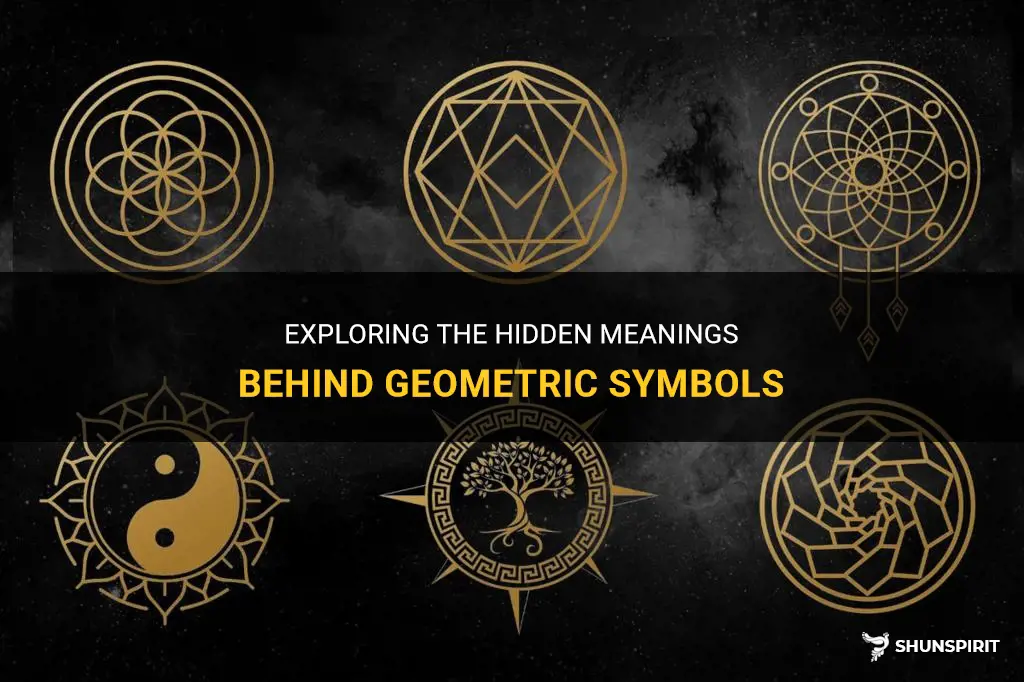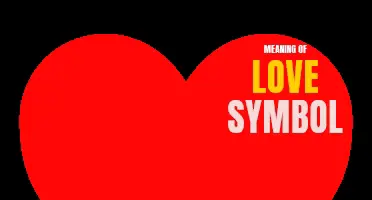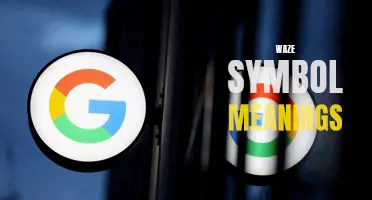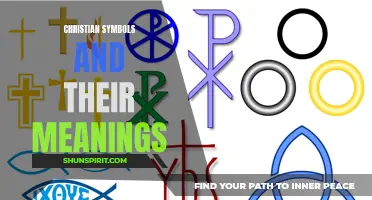
Geometric symbols have been used for centuries to convey complex ideas and concepts in a simple and visually appealing way. From ancient civilizations to modern-day design, these symbols have had profound meanings and significance. Whether it's the circle representing unity and wholeness, the triangle symbolizing balance and harmony, or the square signifying stability and order, geometric symbols have a universal language that transcends cultural and social barriers. In this article, we will explore the fascinating world of geometric symbols and delve into their meanings, exploring the depths of their symbolism and the impact they have on our lives.
What You'll Learn
- What are some commonly used geometric symbols and their meanings?
- How do geometric symbols represent mathematical concepts?
- Can geometric symbols be used to convey ideas or concepts beyond mathematics?
- How have geometric symbols been used in ancient cultures and civilizations?
- Are there any geometric symbols that have multiple meanings or interpretations?

What are some commonly used geometric symbols and their meanings?
Geometric symbols are used in various fields like mathematics, physics, engineering, and design to represent different concepts, shapes, and measurements. These symbols provide a visual representation of mathematical and scientific ideas, making it easier to communicate and understand complex concepts. Here are some commonly used geometric symbols and their meanings:
- Circle: The circle represents a two-dimensional shape that is perfectly round, with all points on its boundary equidistant from the center. It is denoted by the letter "O" or by simply drawing a closed curve.
- Square: The square is a four-sided polygon with equal sides and right angles. It is denoted by a quadrilateral with all sides marked with horizontal lines and right angles at each corner.
- Triangle: The triangle is a three-sided polygon. It is denoted by a shape with three straight lines connected to form a closed figure. The different types of triangles include equilateral (all sides and angles are equal), isosceles (two sides and two angles are equal), and scalene (no sides or angles are equal).
- Rectangle: The rectangle is a four-sided polygon with opposite sides that are equal in length and all interior angles equal to 90 degrees. It is denoted by a quadrilateral with two horizontal and two vertical sides.
- Line: A line is a one-dimensional figure that extends infinitely in both directions. It is denoted by a straight line with distinct endpoints or by using two endpoints and drawing an arrow at each end to indicate it extends indefinitely.
- Point: A point represents a specific location in space. It is denoted by a dot or a small cross.
- Compass: The compass is a tool used for drawing circles and arcs. It consists of two arms, one with a pointed end called the needle or pivot, and the other with an adjustable pencil or pen. It is denoted by a circle with arrows indicating its rotation.
- Angle: An angle is the space between two intersecting lines or surfaces measured in degrees. It is denoted by a curved arc or by Greek letters such as α (alpha), β (beta), or θ (theta).
- Pi (π): Pi is a mathematical constant that represents the ratio of the circumference of a circle to its diameter. It is an irrational number that goes on infinitely without repeating. It is denoted by the Greek letter π.
- Infinity (∞): Infinity represents a concept of endlessness or unlimitedness. It is denoted by a horizontal figure-eight-like symbol.
These are just a few examples of commonly used geometric symbols and their meanings. Understanding these symbols can greatly aid in mathematical and scientific calculations, as well as design and engineering projects.
The Power of Emotional Symbolism: Unveiling the Deeper Meanings Behind Symbols
You may want to see also

How do geometric symbols represent mathematical concepts?
Geometric symbols are an integral part of mathematics, representing various concepts and ideas. These symbols not only simplify mathematical expressions but also provide a visual representation that helps in understanding complex mathematical concepts. In this article, we will explore how geometric symbols represent mathematical concepts.
Basic geometric shapes:
Geometric symbols are often used to represent basic shapes such as squares, circles, triangles, and rectangles. These shapes have specific properties and characteristics that can be defined using symbols. For example, a square is represented by the symbol "□," while a circle is represented by the symbol "○." These symbols help in representing mathematical properties like side lengths, angles, and areas.
Angles:
Angles are an important concept in geometry, and their measurement is represented using symbols. The symbol "∠" is used to represent an angle. The measure of an angle between two lines, rays, or line segments is denoted by three points, with the vertex in the middle. For example, an angle formed between lines AB and BC would be represented as "∠ABC." The numerical value of an angle can be represented using degrees (°) or radians.
Congruent and similar figures:
Geometric symbols are also used to represent congruent and similar figures. Congruent figures have identical shape and size, while similar figures have the same shape but different sizes. The symbol "≅" is used to represent congruent figures, while the symbol "∼" represents similar figures. For example, if two triangles ABC and DEF are congruent, it can be represented as "△ABC ≅ △DEF."
Lines and segments:
Symbols are used to represent lines and line segments in geometry. A line is represented by a straight line with arrows on both ends, while a line segment is represented by a straight line with a specific length, marked by two endpoints. The symbol "|" is used to represent a line, and the symbol "—" is used to represent a line segment. For example, a line segment between points A and B can be represented as "AB."
Polygons and their properties:
Geometric symbols are widely used to represent different types of polygons and their properties. A polygon is a closed figure with straight sides. The symbol "△" represents a triangle, "□" represents a quadrilateral, and "⬟" represents a pentagon. These symbols help in visualizing and representing polygon properties such as sides, angles, and symmetry.
In conclusion, geometric symbols play a crucial role in representing mathematical concepts. They simplify complex mathematical expressions and provide a visual representation that aids in understanding various geometric properties. Whether it's representing basic shapes, angles, congruent figures, or polygons, these symbols help mathematicians and students communicate and analyze mathematical ideas effectively.
Unlocking the Hidden Meanings of Ozark Symbols in Season 1
You may want to see also

Can geometric symbols be used to convey ideas or concepts beyond mathematics?
Geometric symbols have long been associated with mathematics, but they can also be used to convey ideas and concepts beyond the realm of numbers and equations. In fact, geometric symbols have been used for centuries to represent various philosophical, spiritual, and mystical concepts.
One example of a geometric symbol that goes beyond mathematics is the circle. The circle is often used to represent unity, wholeness, and completeness. It is a symbol that transcends cultures and religions, and is often associated with ideas such as eternity and the cyclical nature of life. The circle is also commonly used to represent the concept of "zero," which is the absence of a quantity or the starting point for counting.
Triangles are another geometric symbol that can convey ideas beyond mathematics. The triangle is often used to represent strength, stability, and balance. It is a shape that is structurally sound and stable, making it a fitting symbol for concepts such as stability in relationships, balance in life, or the harmony of mind, body, and spirit.
The square is yet another geometric symbol that can convey ideas beyond mathematics. The square is often associated with order, stability, and structure. It is a shape that is symmetrical and balanced, making it a symbol for concepts such as organization, reliability, and solidity. In spiritual and philosophical contexts, the square can represent the physical world, while the circle represents the spiritual or divine.
Other geometric symbols, such as the pentagon, hexagon, or octagon, can also be used to convey ideas and concepts. For example, the pentagon is often associated with the five elements (earth, air, fire, water, and spirit) and can represent the balance and interconnectedness of these elements. The hexagon is often associated with the concept of harmony and can represent the balance between different forces or energies. The octagon can represent transformation or regeneration, as it is a shape that contains equal parts of the square and the circle.
Geometric symbols have a universal appeal and can be understood and interpreted in different ways by people from different cultures and backgrounds. They are often used in art, design, and architecture to convey complex ideas and concepts in a simple and visually appealing way.
In conclusion, geometric symbols can be used to convey ideas and concepts beyond mathematics. They have been used for centuries to represent philosophical, spiritual, and mystical concepts. The circle, triangle, square, and other geometric symbols can represent unity, strength, order, and balance, among many other ideas. These symbols have a universal appeal and can be interpreted in different ways by different people, making them a powerful tool for communication and representation.
Decoding Hurricane Symbols and Their Hidden Meanings
You may want to see also

How have geometric symbols been used in ancient cultures and civilizations?
Geometric symbols have been used by ancient cultures and civilizations for thousands of years. These symbols not only serve as a form of artistic expression but also hold significant cultural and religious meanings. They can be found in various forms of ancient art, architecture, and even in everyday objects. Let's explore how different ancient cultures used geometric symbols and what significance they held.
Ancient Egyptians were highly skilled in using geometric symbols in their art and architecture. The most well-known geometric symbol used by the Egyptians is the pyramid. The pyramid represented the link between the earth and the heavens, symbolizing the journey to the afterlife. The Egyptians also used other geometric shapes such as circles and squares in their art to represent harmony, balance, and the eternal nature of life. These symbols were often incorporated into wall paintings, jewelry, and even on the surfaces of their temples.
In ancient Mesopotamia, the use of geometric symbols was prevalent in their architectural designs. The Babylonians and Sumerians used Ziggurats, which were step-like geometric structures. These structures served as temples and were believed to connect the earthly realm to the heavens. The steps of the ziggurat were often adorned with geometric patterns, representing the order and balance of the universe.
The Greeks, known for their advancements in mathematics and geometry, also incorporated geometric symbols in their art and architecture. The most famous example is the use of the golden ratio in the design of the Parthenon. The golden ratio is a mathematical ratio that is believed to create a sense of visual harmony and beauty. The Greeks also used other geometric symbols such as the meander pattern, which consists of interlocking lines, to decorate their pottery and buildings.
In ancient Mesoamerica, the Maya civilization used geometric symbols in their art and architecture as well. The Maya were known for their advanced knowledge of astronomy, and many of their symbols were related to celestial bodies. They used circular symbols, known as glyphs, to represent the sun, moon, and stars. These glyphs were often incorporated into their intricate stone carvings and murals.
Across different cultures, geometric symbols held similar meanings and significance. They often represented concepts such as the order of the universe, the balance between opposing forces, and the connection between the earthly and spiritual realms. These symbols were not only decorative but also served as a way to communicate complex ideas and cultural beliefs.
In conclusion, geometric symbols have played a crucial role in the artistic expression of ancient cultures and civilizations. They were used by the Egyptians, Mesopotamians, Greeks, and Maya, among others, in their art, architecture, and everyday objects. These symbols held deep cultural and religious meanings, symbolizing concepts such as harmony, balance, and the connection between the earthly and spiritual realms. The use of geometric symbols not only showcased the skilled craftsmanship of these ancient civilizations but also provided a means to communicate complex ideas and beliefs.
Decoding the Symbols on Your Omron Blood Pressure Monitor: What Do They Mean?
You may want to see also

Are there any geometric symbols that have multiple meanings or interpretations?
Geometric symbols have been used by cultures throughout history to convey information and communicate complex ideas. While many symbols have well-defined meanings, there are some geometric symbols that have multiple interpretations or can be interpreted in different ways.
One such symbol is the circle. The circle is one of the most basic geometric shapes and is often associated with unity, wholeness, and infinity. It has no beginning or end and is seen as a symbol of perfection and completeness. However, the circle can also represent cycles, such as the cycle of life and death, or the cycle of the seasons. It can also be seen as a symbol of protection and enclosure. In some cultures, the circle is used as a symbol of the sun or the moon, while in others it can represent the divine or spiritual realms.
Another geometric symbol that can have multiple meanings is the triangle. The triangle is often associated with balance, harmony, and stability. It is also seen as a symbol of change and transformation, with each point representing a different aspect of the self or a different stage of life. In some cultures, the triangle is used to represent the elements, such as fire, water, and air, or the three realms of existence - the physical, mental, and spiritual. However, the triangle can also symbolize conflict or tension, with each point representing opposing forces or ideas.
The square is another geometric symbol that can have diverse meanings. It is often associated with stability, solidity, and order. It represents the four elements - earth, air, fire, and water - and the four cardinal directions - north, south, east, and west. The square can also symbolize balance and equality, as well as confinement or restriction. In some cultures, the square is used to represent the physical world or the material realm, while in others it can symbolize the four seasons or the four stages of life.
Triangles, circles, and squares are just a few examples of geometric symbols that can have multiple interpretations or meanings. The meanings of these symbols can vary depending on cultural or religious beliefs, personal associations, or the context in which they are used. It is important to remember that symbols are open to interpretation and can have different meanings for different people. Therefore, understanding the cultural and historical context of a symbol is crucial in order to fully grasp its intended meaning.
The Enigmatic Symbolism of the Falcon: Insights into its Meaning and Significance
You may want to see also
Frequently asked questions
In geometry, the triangle symbolizes balance and strength. It is a fundamental shape that is used to represent many different concepts in mathematics, including angles, congruence, and similarity.
In geometry, the circle symbolizes unity and perfection. It is a shape with no beginning or end, and its symmetry represents balance and harmony. Circles are used to represent many properties in geometry, such as circumference, area, and arc length.
In geometry, the square symbolizes stability and equality. It is a shape with four equal sides and four right angles, which represents balance and fairness. Squares are used to represent many concepts in geometry, including area, perimeter, and congruence.
In geometry, the line symbolizes the most basic element of geometry. It has no thickness or width, and it extends infinitely in both directions. Lines are used to represent many properties in geometry, such as length, slope, and intersection. They are a fundamental concept in understanding the relationships between points and shapes.







